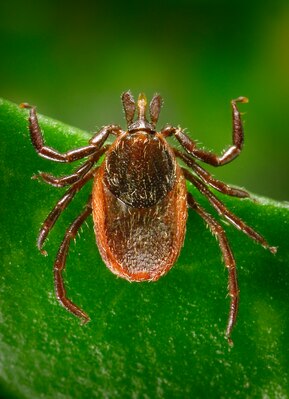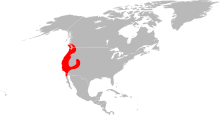Ixodes pacificus
| Ixodes pacificus | ||||||||||||
|---|---|---|---|---|---|---|---|---|---|---|---|---|

Ixodes pacificus , adult female |
||||||||||||
| Systematics | ||||||||||||
|
||||||||||||
| Scientific name | ||||||||||||
| Ixodes pacificus | ||||||||||||
| Cooley & Kohls , 1943 |
Ixodes pacificus is a western North America , particularly on the Pacific coast, non- tick species from the genus Ixodes within the family of the ticks (Ixodidae). It is the carrier of Lyme borreliosis in its area of distribution.
features
description
In both sexes, the front body (the gnathosoma ), the shield (the scutum ) and the legs are black-brown and slightly hairy. The scutum has hairs arranged in rows.
The body length of the females is 2.6 mm when sober and the width 1.1 mm. In the saturated state, a length of 9 mm can be achieved. The body has an approximately elliptical shape. The scutum of fasting animals takes up about half the body length. The brown alloscutum is hairy over the entire surface, with narrow but pronounced folds, and swells in the course of a meal to many times its original size.
The males have a body length of about 2.2 mm and a width of 1.3 mm. Their body is approximately oval in shape, with a slightly wider rear part. The scutum takes up almost the entire surface of the body.
The nymphs of Ixodes pacificus can be distinguished from those of Ixodes californicus , which occurs in the same habitat, by the lack of lobes at the base of the gnathosoma.
distribution and habitat

Ixodes pacificus is common in the western half of North America. Its main distribution area is in the coastal states, from British Columbia in Canada in the north to Baja California Norte in Mexico in the south. There are also populations in the arid interior of the country, for example in Mohave County , Arizona and in southwest Utah . These marginal populations show no evidence of genetic isolation.
Adult Ixodes pacificus inhabit very different habitats, from forests of sequoias or Douglas firs to chaparrals and open grasslands. The species prefers the lowlands, but was found in one case at an altitude of 2345 m. The nymphs have higher demands on their habitat than the adult animals. They occur in large numbers where there are old trees and lots of leaves.
In the east of the continent, the ecological role of the Ixodes pacificus , which is tolerant of heat and drought, is performed by Ixodes scapularis , which cannot spread further west due to its need for moisture and its sensitivity to drying out.
Way of life

Ixodes pacificus feeds on the blood of vertebrates in all three stages - larva, nymph and tick. It parasitizes a wide range of hosts, with the adults mainly affecting mammals and the nymphs and larvae affecting birds and reptiles. For adult Ixodes pacificus 29 mammal species, 2 bird species and one reptile species have been identified as hosts in California alone. Nymphs attacked 30 species of mammals, 38 species of birds and 8 species of reptiles, and the larvae were found on 29 species of mammals, 43 species of birds and 8 species of reptiles.
The large number of potential hosts does not reflect the frequency of their infestation. The main host of adult Ixodes pacificus is the mule deer . Hosts of nymphs and larvae are primarily rodents and other small mammals, chicken birds and songbirds , as well as crocodile Sneak genus Elgaria and spiny lizards , especially Sceloporus occidentalis . The infested birds are of great importance in the spread of ticks.
Medical importance
Borreliosis

Ixodes pacificus is the most important vector of Borrelia burgdorferi , a bacterium that causes Lyme disease and Lyme disease in dogs , in the western half of the United States . This means that it has the same importance for the healthcare system in its area of distribution as the common wood tick in Europe. Ixodes pacificus is also a vector of Borrelia bissettii , a bacterial species that is closely related to Borrelia burgdorferi but is less important as a pathogen for humans.
The mechanism of transmission means that ticks that suckle on infected hosts ingest Borrelia, become carriers themselves and infect the new host when they eat another meal. In addition to this horizontal transmission through the ingestion of infected blood, Borrelia is also transmitted vertically in the tick population, an infected female tick almost exclusively produces already infected offspring.
The blood serum of various species of deer contains a substance that is toxic to Borrelia burgdorferi . In addition, numerous types of iguanas and crawfish also have a substance in their blood serum that kills Borrelia. The result is not just extensive host immunity. Ixodes pacificus nymphs infected with Borrelia burgdorferi showed no more Borrelia in their digestive tract after a blood meal on the spiny iguanas Sceloporus occidentalis and were free of pathogens even after they had developed into adults. This indirectly reduces the proportion of infected ticks in a population.
Anaplasmosis
Ixodes pacificus is the carrier of the bacterium Anaplasma phagocytophilum , which causes life-threatening human granulocytic anaplasmosis in humans and canine anaplasmosis in dogs . Cats, ruminants and horses can also be infected.
Bartonellos
Various bacteria of the genus Bartonella were found in Ixodes pacificus . It is unclear whether ticks are important as carriers of pathogens that cause human bartonellosis .
Tick paralysis
The clinical picture of tick paralysis , which is triggered by the neurotoxins contained in the saliva of many ticks , has so far only been described for Ixodes pacificus by dogs.
Systematics
Ixodes pacificus heard with approximately 250 other types of globally extended genus Ixodes in the family of the ticks (Ixodidae). No subspecies have been described.
The first description of Ixodes pacificus was made in 1943 by Robert A. Cooley and Glen M. Kohls in the entomological journal Pan-Pacific Entomologist . The basis of the description was a collection from 1932 of five female and one male from Monterey County, California, and nymphs from Vancouver , Canada.
The female holotype , allotype, and several paratypes of adults and nymphs are held in the United States National Tick Collection in Statesboro , Georgia. Additional paratypes of adults and nymphs are located in the Louis Agassiz Museum of Comparative Zoology in Cambridge, Massachusetts and in the University of California, Berkeley . The species name pacificus refers to the main range of the species, the North American Pacific coast.
literature
- Robert A. Cooley and Glen M. Kohls: Ixodes californicus Banks, 1904, Ixodes pacificus n. Sp., And Ixodes conepati n. Sp. In: Pan-Pacific Entomologist 1943, Volume 19, No. 4, pp. 139-147, digitized .
- Alberto A. Guglielmone et al .: The Hard Ticks of the World (Acari: Ixodida: Ixodidae). Springer, Dordrecht 2014, ISBN 978-94-007-7496-4 .
- Joseph F. Piesman and Lise Gern: Lyme borreliosis in Europe and North America. In: Alan S. Bowman and Patricia A. Nuttall (Eds.): Ticks. Biology, Disease, and Control. Cambridge: Cambridge University Press 2008, pp. 220-252, ISBN 978-0-521-86761-0 .
Individual evidence
- ↑ a b Robert A. Cooley and Glen M. Kohls: Ixodes californicus Banks, 1904, Ixodes pacificus n. Sp., And Ixodes conepati n. Sp., Pp. 140-142.
- ^ Robert A. Cooley and Glen M. Kohls: Ixodes californicus Banks, 1904, Ixodes pacificus n. Sp., And Ixodes conepati n. Sp., P. 143.
- ↑ a b c Robert A. Cooley and Glen M. Kohls: Ixodes californicus Banks, 1904, Ixodes pacificus n. Sp., And Ixodes conepati n. Sp., P. 144.
- ↑ David T. Dennis et al .: Reported Distribution of Ixodes scapularis and Ixodes pacificus (Acari: Ixodidae) in the United States. In: Journal of Medical Entomology 1998, Volume 35, No. 5, pp. 629-638, doi : 10.1093 / jmedent / 35.5.629 .
- ↑ a b c d Joseph F. Piesman and Lise Gern: Lyme borreliosis in Europe and North America, pp. 228-230.
- ^ Martin B. Castro and Stan A. Wright: Vertebrate hosts of Ixodes pacificus (Acari: Ixodidae) in California. In: Journal of Vector Ecology 2007, Volume 32, No. 1, pp. 140-149, doi : 10.3376 / 1081-1710 (2007) 32 [140: VHOIPA] 2.0.CO; 2 .
- ^ A b c Joseph F. Piesman and Lise Gern: Lyme borreliosis in Europe and North America, pp. 232-233.
- ^ Sarah E. Randolph: The impact of tick ecology on pathogen transmission dynamics. In: Alan S. Bowman and Patricia A. Nuttall (Eds.): Ticks. Biology, Disease, and Control. Cambridge: Cambridge University Press 2008, pp. 40-72, here p. 59, ISBN 978-0-521-86761-0 .
- ^ A b Robert S. Lane and GB Quistad: Borreliacidal Factor in the Blood of the Western Fence Lizard (Sceloporus occidentalis). In: Journal of Parasitology 1998, Volume 84, No. 1, pp. 29-34, doi : 10.2307 / 3284524 .
- ↑ Joseph F. Piesman and Lise Gern: Lyme borreliosis in Europe and North America, S. 222nd
- ^ Robert S. Lane and Willy Burgdorfer: Transovarial and Transstadial Passage of Borrelia burgdorferi in the Western Black-Legged Tick, Ixodes pacificus (Acari: Ixodidae). In: American Journal of Tropical Medicine and Hygiene 1987, Volume 37, No. 1, pp. 188-192, doi : 10.4269 / ajtmh.1987.37.188 .
- ↑ PJ Richter et al .: Ixodes pacificus (Acari: Ixodidae) as a Vector of Ehrlichia equi (Rickettsiales: Ehrlichieae). In: Journal of Medical Entomology 1996, Volume 33, No. 1, pp. 1-5, doi : 10.1093 / jmedent / 33.1.1 .
- ↑ Sam R. Telford and Heidi K. Goethert: Emerging and emergent tick-borne infections. In: Alan S. Bowman and Patricia A. Nuttall (Eds.): Ticks. Biology, Disease, and Control. Cambridge: Cambridge University Press 2008, pp. 344-376, here p. 347, ISBN 978-0-521-86761-0 .
- ↑ CC Chang et al .: Molecular Evidence of Bartonella spp. in Questing Adult Ixodes pacificus Ticks in California. In: Journal of Clinical Microbiology 2001, Volume 39, No. 4, pp. 1221-1226, doi : 10.1128 / JCM.39.4.1221-1226.2001 .
- ↑ Ben J. Mans, Rainer Gothe and Albert WH Neitz: Tick toxins: perspectives on paralysis and other forms of toxicoses caused by ticks. In: Alan S. Bowman and Patricia A. Nuttall (Eds.): Ticks. Biology, Disease, and Control. Cambridge: Cambridge University Press 2008, pp. 108-126, here p. 111, ISBN 978-0-521-86761-0 .
- ^ A b Alberto A. Guglielmone et al .: The Hard Ticks of the World, p. 146.
Web links
- Western blacklegged tick , University of Rhode Island, TickEncounter Resource Center (English)
